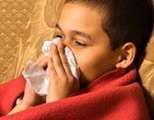What is H1N1 flu?
H1N1 flu is a respiratory infection of pigs caused by type A influenza viruses. People can be infected with H1N1 flu. H1N1 flu can spread from pigs to people and from one person to another.
How is H1N1 flu spread?
 It is thought that H1N1 flu spreads from person to person in a similar way to regular seasonal flu. Germs are released into the air through coughing and sneezing and the droplets enter the nose or throat of others. You may also become infected by touching something with the flu virus on it and then touching your eyes, nose or mouth, before washing your hands.
It is thought that H1N1 flu spreads from person to person in a similar way to regular seasonal flu. Germs are released into the air through coughing and sneezing and the droplets enter the nose or throat of others. You may also become infected by touching something with the flu virus on it and then touching your eyes, nose or mouth, before washing your hands.
If I had a flu shot, am I protected against H1N1 flu?
It is unlikely that the seasonal flu shot will provide protection against H1N1 flu.
What are the symptoms of H1N1 flu?
The common symptoms of H1N1 flu are similar to those of seasonal flu and may include fever, cough, sore throat, body aches, headache, diarrhea, vomiting, chills and fatigue.
How can I reduce my risk of catching/spreading H1N1 flu?
- The most important step you can take is to wash your hands often with soap and warm water, or use an alcohol-based hand sanitizer. See the instructions on how to properly wash your hands on this sheet.
- Maintain a healthy lifestyle: consume a healthy diet, get plenty of sleep, be physically active and manage your stress.
- Try to avoid close contact with people who are sick. Avoid touching surfaces that may be contaminated by the flu virus.
- Avoid touching your eyes, nose and mouth to reduce the spread of germs.
- You cannot catch the H1N1 flu from eating pork.
- If you are infected with H1N1 flu: Stay home.
- Cough or sneeze into your sleeve or cover your nose and mouth with a tissue when you cough or sneeze; throw the tissue away after you use it.
- Wash your hands often, especially when you cough or sneeze.
- Try to avoid close contact with others.
If I get H1N1 flu, how can I manage my symptoms?
- There are antiviral prescription medications that may be helpful in both preventing and treating the flu. For best results they must be started as soon possible after you become sick, usually within two days of symptoms. Ask the Pharmacist at Walmart for more information.
- You may also try the following:
- Pain- and fever-reducing medications such as acetaminophen or ibuprofen (available at Walmart Pharmacy).
- Gargle with salt water solution Ch teaspoon salt in 8 oz. warm water).
- If you are a smoker, stop smoking.
- Get plenty of rest.
- Drink plenty of fluids (juices, tea, soups).
Should I go to the doctor if I think I have H1N1 flu?
If you think you may have H1N1 flu and you are worried about your symp¬toms, call your doctor. Emergency warning signs require immediate medical attention:
- Emergency Warning Signs in Children: Fast or troubled breathing; bluish skin colour; not drinking enough fluids; not waking up or interacting; flu-like symptoms improve and then return and worsen; fever with a rash.
- Emergency Warning Signs in Adults:
- Difficulty breathing, shortness of breath; pain or pressure in the abdomen or chest; sudden dizziness; confusion; severe or persistent vomiting.
- Proper Handwashing Technique The Public Health Agency of Canada recommends considering the following information about handwashing.
Wash your hands several times a day with soap and warm water and especially:
- Before meals;
- Before feeding children;
- Before and after preparing food;
- After using the toilet, or helping someone else use the toilet;
- After blowing your nose, coughing or sneezing;
- After playing with shared toys;
- Before and after visiting or caring for people who are sick.
How to wash your hands:
- Wet your hands with warm running water.
- Use a bar of soap that is not sitting in water or put a small amount of liquid soap in the palm of one hand.
- Rub your hands together for 20 seconds so that you produce lather. Scrub between your fingers, under your fingernails and the backs of your hands.
- Rinse your hands well with clean running water for at least 10 seconds.
- Dry your hands with a single-use paper towel. If you use a cloth hand towel, change it daily and give each family member his/her own hand towel.
- Try to turn off faucets with the paper towel.
- Model good handwashing t
No comments:
Post a Comment